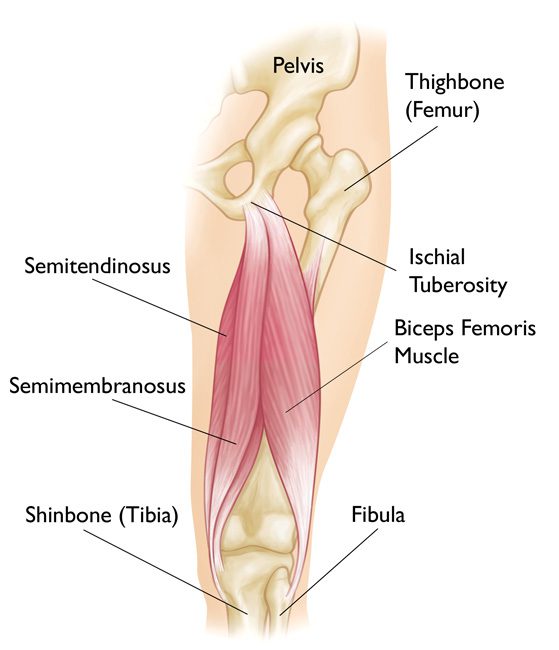Yoga can ask a lot of our hamstrings.
This is what they look like, as an illustration at least (back of the right leg):

Image: Norris Health.
There are three (some say four) hamstring muscles. The semitendinosus and semimembranosus medially (closer to the inner thigh) and the two-portioned biceps femoris laterally (closer to the outer thigh). You can see how they attach to the sitting bones (ischial tuberosities, for three of the four parts) and the lower backs of the knees (at the tibia and fibula bones). Broadly speaking, they extend the hip joint (take the leg back) and flex the knee joint. They are also involved in medial (inward) and lateral (outward) rotation of the knee joint when flexed. We’ll be exploring all this in the first video exercise below.
Why do we struggle with hamstrings in yoga?
Hamstrings are potentially shortened in many activities in daily life – sitting, driving, walking, running or cycling to name a few. These muscles easily remain ‘switched on’ or ‘held’, losing the ability to release, and tightness becomes entrenched. Stretching at this stage is not helpful. Release is needed first and foremost.
For yoga, hamstrings need to be adaptable: actively engaged and strong to support us in many poses and sufficiently long to enable others.
Healthy resting tone
When hamstrings have a healthy resting tone, free of residual tension and free to engage and disengage when needed, the whole lower body feels steady and grounded, we naturally stand tall and breathe more freely. There is also less chance of related strain on the lower back or compensations in other parts of the body.
Some seem to have elastic bands for hamstrings and appear to lie on their legs (or the floor) in a seated forward bend. For most of us though, this just isn’t the case!
Here are two short videos to help free us of tightness in all the hamstring muscles, and restore optimal, responsive tone. The principle here is to first go gently into the contraction of the muscles (a familiar pattern) and then release very, very slowly and consciously, to re-introduce a forgotten pattern and brain-body connection.
Video 1: Hamstring release exercise
I do two repetitions of each movement in the clip below. Once you’re used to the exercise, three reps would be ideal. Most important is to release very slowly from the muscular contraction. Please replay to practise with the other leg. You can do this exercise at any time of the day, and ideally before your yoga practice.
This exercise can also be done lying on the floor, on the back or front. If standing doesn’t feel right for you and you’d like some assistance, please contact me.
Video 2: Calf release exercise
A bonus for the backs of the legs now. Calf muscles (gastrocnemius and soleus) can also very easily become tight as they’re used when we walk, run, jump, drive, go up onto the balls of our feet and engage in sport, for example.
When you release the calf muscles before your yoga practice (or at any time during the day) it’s likely that the warm-up, surya namaskar (sun salutations), adho mukha svanasana (downward facing dog) and initial standing poses will immediately feel better.
Below is a very short, simple exercise that will help. You may wish to keep using this exercise as and when you feel the need, to support your practice and general physical ease in daily life.
The body moves and breathes as a whole. For the optimum comfort and functionality of the hamstrings, a healthy lower back (a couple of posts are linked below) is helpful, as are balanced quadriceps (front thigh muscles). It’s also worth addressing any tightness in the soles of the feet and in the gluteal muscles.
As ever, a well-rounded yoga practice will help to ensure that this is all automatically taken care of, and will keep your hamstrings happy, as long as they remember how to release.
In Part Two I address how the functional anatomy of the hamstrings informs our alignment in yoga practice, in forward bends in particular. Sometimes we are actually unwittingly contributing to tightness or structural stress in our practice.
Any questions, or in need of practice support? Please feel free to contact me.
A word of caution. If you experience sharp pain around the attachment points of the hamstrings – either proximally at the sitting bones (ischial tuberosities), or distally at the back of the knee(s) – it’s best to see a physiotherapist or physical therapist in the first instance.
You may also like:
Happy Hamstrings Part Two: Forward Bends
Yoga for lower back relief: 4 poses
Yoga for lower back relief: 3 backbends